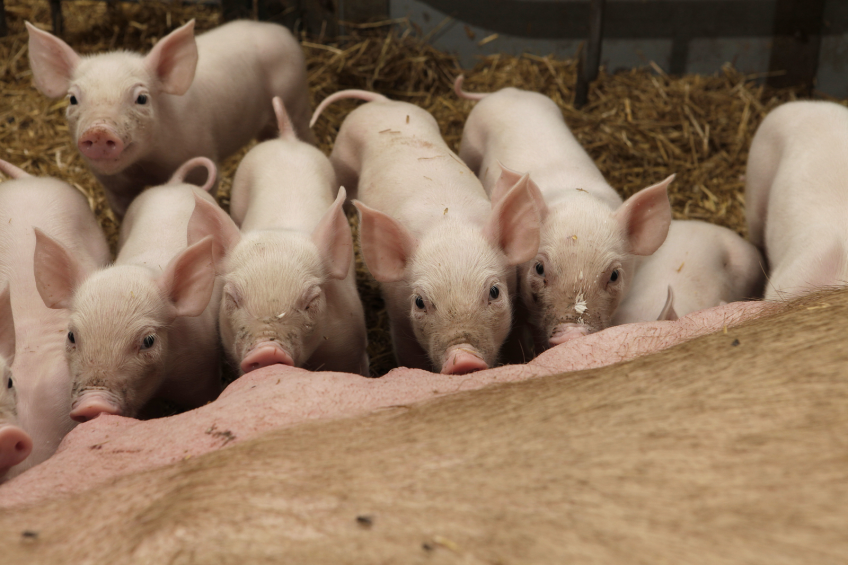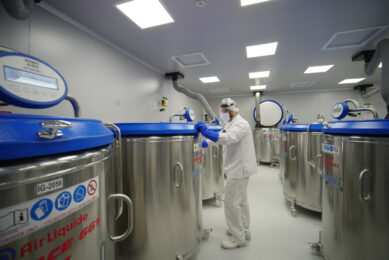Colostrum: Key to prevent diarrhoea in suckling pigs

It’s an old acquaintance of pig farmers, a very well-known phenomenon: scouring piglets in the farrowing house. There are ways to avoid it – not surprisingly, colostrum plays an important role in this process.
Following a good start, it is a matter of keeping the piglets healthy through to weaning (and beyond). Piglets are born without any immune protection and it takes a couple of weeks before they can build their own active immunity. The only way to protect them in these critical weeks is through passive immunity supplied by the sow.
Colostrum is the first milk secreted. A sufficient colostrum intake in the first hours after birth is one of the most important success factors for pig performance. Colostrum does not only provide the vital energy and proteins essential for the piglets to start suckling and to grow, it is also enriched with the maternal antibodies (immunoglobulins) which provide passive immunity. Naturally, maternal antibodies are built when a sow gets infected with a pathogen. A safer and more consistent way to induce maternal antibodies is by sow vaccination.
Sufficient early colostrum intake is essential
Colostrum intake depends on the amount of colostrum produced by the sow and the ability of the piglet to suckle. Colostrum excretion starts shortly before parturition and ends about 24 hours after farrowing.
The first 6 hours are critical, and after 24 hours the gut closes not allowing the immunoglobulins to be absorbed. In contrast to milk yield, colostrum yield is not related to litter size, so the larger the litter the lower the amount of colostrum per pig (see Table 1). A study revealed that up to one third of the sows do not produce enough colostrum to cover the needs of all their piglets.
Piglets need colostrum intake of 250 g (minimum)
An insufficient colostrum intake is one of the main reasons for pre-weaning mortality. Studies have shown that on average 25% of pigs with a colostrum intake below 200 g die, in pigs with a colostrum intake below 100 g mortality was as high as 65%. Based on those studies, a colostrum intake of at least 250 g per piglet is recommended, which is not easy to achieve with highly prolific sows taking into account that sows on average produce about 3 to 4 l of colostrum.
A sufficient number of functional teats (at least as many as live-born piglets) help to ensure that every pig gets enough colostrum. It is vital to keep in mind that rear teats produce less colostrum (and less milk too) than the front ones.
A fast and smooth farrowing at term is essential
A healthy and vital piglet at birth is a good start. For that a fast and smooth farrowing at term is essential. Early farrowing not only reduces the colostrum yield, but increases the risk of weak and stillborn piglets. On the other side, vitality of healthy pigs decreases with a prolonged and complicated farrowing. In case of prolonged farrowing due to weak uterine contractions, oxytocin can be given. It should be used carefully, as in case of misuse or over dosage, it might result in uterus spasms leading to discontinuation of the delivery process. A spasmolytic medication, like vetrabutin hydrochlorid, that regulates uterine contractions by influencing the tonus, strength and rhythm of contractions is advisable when the farrowing is prolonged due to a small, narrow or blocked birth canal.
To ensure sufficient colostrum intake, it is important that the sow lets the piglets suckle for a long enough time. Motherly behaviour is influenced by genetic selection. In the delivery room stress or pain can lead to unwillingness of the sow to settle down and let her pigs suckle.
How to achieve a high colostrum yield
Genetic factors have an influence on the potential of sows to produce colostrum. During gestation and around farrowing you can ensure that the sows can exploit that potential to a maximum.
Sows with heavy litters at birth with little weight variation usually have a high colostrum yield. A good body condition of the sow during gestation and at farrowing will reduce within-litter variation in birth weight and prevents metabolic disorders which may cause mastitis and can lead to a reduced colostrum yield. Proper feeding from day 85 onwards is even more relevant than in mid gestation as in late gestation new mammary tissue is produced and the piglet’s birth weight is established.
Any sow stressors in the farrowing room can have a negative influence on colostrum yield including heat stress due to ambient temperatures above 21°C, slippery floors, injuries or fever. It can be useful to treat sows orally or by injection with meloxicam, which reduces pain, inflammation and fever, to maximise early colostrum intake.
Colostrum: Passive immunity against diarrhoea
Sow vaccination against Coli and Clostridia infection is a common tool to reduce diarrhoea in suckling pigs. Vaccination induces the production of antibodies in the sow which are transferred via the colostrum and provide passive immunity to the piglets.
A vaccine consists of 2 relevant components:
- antigen
- adjuvant
In brief, the antigen determines against which diseases or pathogens the vaccine is protecting, while the adjuvant determines the type of immune response.
Unlike with other diseases, it is well-known that with Coli and Clostridia infections, the level of protection is linked to the levels of antibodies induced by the vaccine. While oil-based vaccines are best to induce high levels of antibodies, they can have the disadvantage of being sticky and difficult to inject. In addition, some oil-based vaccines tend to induce severe local reactions. With modern vaccinology it is possible to develop new types of oil-based vaccines, so called water-in-oil-in-water emulsions. Those do not have the disadvantages mentioned, while still inducing the high levels of antibodies needed to provide effective and long lasting passive immunity.
Concerning the selection of antigens, it is important that they cover the strains relevant in the field. E. coli not only causes neonatal diarrhoea, it can also cause diarrhoea shortly before or after weaning. Recently a new Coli-Clostridia vaccine was launched in Europe based on a water-in-oil-in-water emulsion that is able to provide maternal protection up to 28 days of age and covers strains relevant for neonatal diarrhoea as well as ‘late’ diarrhoea around weaning.
Lastly, a little word of caution, even the best sow vaccine will fail if the piglets do not get enough colostrum. That is why proper colostrum management is so important.











